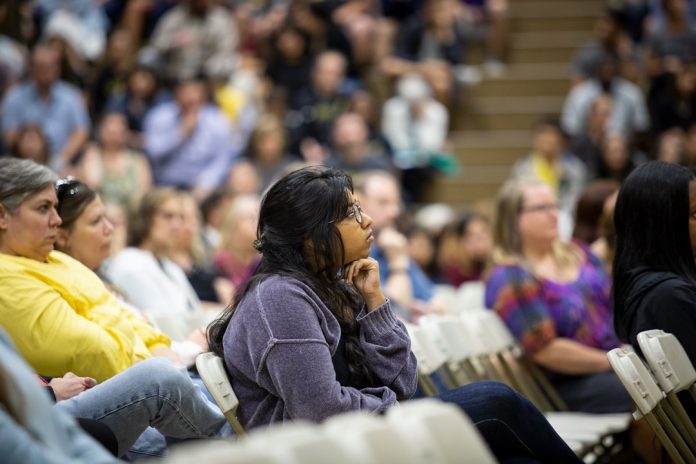
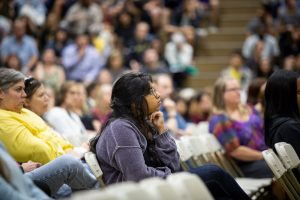
The change in the structure of Wednesday’s DePauw Dialogue was met with mixed reviews from participants. Many students who attended DePauw Dialogue in previous years saw the shift to student and faculty leadership as a positive one.
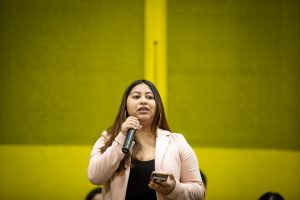
This year, DePauw Dialogue was mainly student and faculty-led. Multiple students shared the stage during the keynote and every participant was assigned a room at random for small group discussions following the keynote. The structure of the day was different from past years in which paid professionals gave the keynote address and students could choose from a variety of break out workshops.
Emma Wittowski, senior, enjoyed the keynote because it was student-driven and student-led.
“It recorded real life experiences on this campus, which I think is an important place to start within your own community, and then move out when discussing real world issues,” Wittowski said.
Emma Rees, junior, read a personal poem during the keynote and lead a circle discussion.
“The facilitator circles depend on who is actually there to learn and engage in conversation,” Rees said. “I was lucky enough to lead a group that was willing to discuss what issues are relevant to us and agree on what needs to be changed. It felt like a safe space for the moment.”
The circle process was designed to allow members of the small groups to talk without being interrupted. Each group used a talking piece, which for some groups, was a stone, or small item that was passed around the circle. One could only speak when they were in possession of the talking piece.
Austin Lewis, senior and DePauw Dialogue facilitator, said he got involved with leading the day because he saw “the opportunity to do good and be a part of positive change.”
While Lewis said he can only speak for his small group, he felt the new format was “incredibly successful,” a sentiment that was shared by members of the group he led.
The student-led, small group format also worked well for junior Blane Cook.
“I really liked my small group, and everybody was really respectful of each other’s opinions,” Cook said. “I think that’s the foundation they’ve worked on as our years have progressed. At least from my experience, they were able to achieve that this year.”
Other participants who have attended previous DePauw Dialogues said the student-led day allowed for a greater sense of community.
Sophomore Sasha Taxter felt that the keynote speakers set the tone for the day.
“Going into DePauw Dialogue I feel like a lot of people blow it off and don’t take it seriously, but after the opening ceremony I could tell that people cared more and I cared more,” Taxter said.
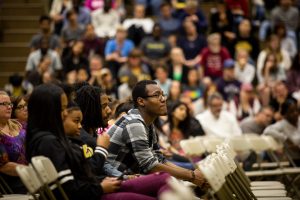
Senior Salma Allam also appreciated “the emphasis on having people in the community lead the day.” Allam said that the decision to rely on DePauw community members was met with criticism initially, but she was glad to hear from her group at the end of the day say they liked the community-led structure.
Junior Diana Jiang decided to volunteer as a facilitator because she wanted to do more for DePauw. She also said she wanted to experience DePauw Dialogue from a different perspective.
“Day of Dialogue is such an essential part for DePauw. At that day we take a step back to reflect on ourselves and figure out ways to make DePauw go better,” Jiang said.
Although some participants were in favor of the changes made to DePauw Dialogue, other students still said the day’s structure could be improved.
Jiang said that most everything went smoothly, but she wasn’t as prepared for the circle talking sessions as she would have liked. This was due to receiving additional instructions for leading the circle discussions right as her group began showing up.
“I was told that there should be 12 people in my circle, 20 at most, but we actually had 27 people in our circle. I’m glad that there are more people coming, but I was really nervous. I wish I could have had those materials the day before dialogue,” Jiang said.
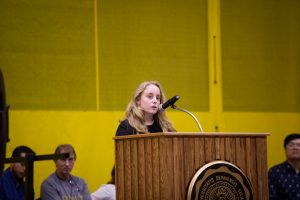
Students also found it difficult to discuss certain topics in great depth throughout the group sessions. These topics focused on large and complicated issues on DePauw's campus and included, racism, sexual assault, Greek Life, mental health and more.
Wittowski said, “I enjoyed the small group activities and the fact that we were actually able to discuss all of these topics, however, I think it’s hard to discuss multiple topics in depth and get anything out of it in such a short amount of time.”
Sophomore Mana Kunimatsu said, “It was nice that we all got to talk because we kept on passing the stone till the end, but it wasn’t exactly a conversation. There was no feedback. It still kind of felt not completely connected.”
She said that there are pros and cons to this year’s and last year’s format, but she liked that last year there was a single topic to focus discussion.
“This year we spent a lot of time choosing the topic, and I think it was hard discussing in depth because of the time,” Kunimatsu said.
Lack of genuine participation was also a challenge for a few small groups. Senior Noah Boyce recognized this as one of the difficulties that still remains in DePauw Dialogue’s structure.
“It was underwhelming because I don’t think that my group felt comfortable enough to deviate from the promoted questions, so our conversation was a bit artificial.”
The final critique of this year’s DePauw Dialogue was on the circle process, which some found as a difficult means to produce true dialogue.
Jana Grimes, executive director of human resources at DePauw, facilitated a circle group discussion.
“The circle process felt like... it wasn’t really a dialogue. It was more about individual responses rather than a dialogue, but we changed it up to make sure that it was a dialogue.”
With critiques of the day’s structure, students also offered suggestions on how the day could be improved.
Mariah De La Fuente, a junior who both spoke at the keynote and facilitated a circle discussion said, “A lot of concerns that I heard was that there was no specific topic that these circles were talking about. So maybe next year we can do a better job of asking questions that could get people to be less surface level.”
She added that some people wished there was a planned way to continue discussions outside of DePauw Dialogue, “so that we are creating community and building community, but then we’re also following up with it and we’re not strangers the next day that we see each other.”
De La Fuente said, “But even the step toward peace circles this year did a lot of community building that we’re not going to be able to have these dialogues without.”
First-year Bradon Collins also offered insight on how the structure of DePauw Dialogue could improve.
“In order to truly fix these issues we need to educate not only the people going to these events, but also those that are not. More events, more education that is required and caters to this kind of conversation.”
The DePauw reporters Ian Brundige, Joslyn Fox, Maddy McTigue, Michael Ocasek, Aaron Sandal, and Angela Xinye Yang contributed to this report.


